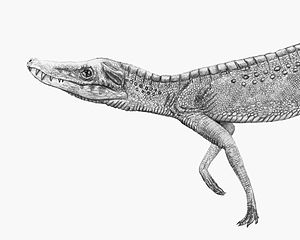Sphenosuchia
aus Wikipedia, der freien Enzyklopädie
| Sphenosuchia | ||||||||||||
|---|---|---|---|---|---|---|---|---|---|---|---|---|

Junggarsuchus sloani | ||||||||||||
| Zeitliches Auftreten | ||||||||||||
| Obertrias bis Oberjura | ||||||||||||
| 228 bis 150 Mio. Jahre | ||||||||||||
| Fundorte | ||||||||||||
| ||||||||||||
| Systematik | ||||||||||||
| ||||||||||||
| Wissenschaftlicher Name | ||||||||||||
| Sphenosuchia | ||||||||||||
| von Huene, 1942 |
Die Sphenosuchia sind ein Taxon der Reptilien aus der Obertrias und dem Oberjura und sind frühe Angehörige der Crocodylomorpha, ein Taxon, das die Verwandten der Krokodile mit letzteren vereint. Die Sphenosuchia waren kleine und mittelgroße, leicht gebaute terrestrisch lebende Tiere. Die Gruppe ist eventuell nicht monophyletisch[1].
Merkmale
[Bearbeiten | Quelltext bearbeiten]Sie sind vor allem durch das Fehlen der abgeleiteten Merkmale der Krokodile charakterisiert. Die Pneumatisierung der hinteren Schädelregion ist noch nicht so stark entwickelt. Der Schädel war niedrig und hatte mit seiner verlängerten Schnauze eine deutlich krokodilartige Form. Ein sekundärer Gaumen war noch nicht oder nur in Ansätzen vorhanden. Die Beine waren, verglichen mit denen der Krokodile, sehr lang, Vorder- und Hinterbeine waren fast gleich lang. Sie waren Zehengänger, ihre Handwurzelknochen waren verlängert. Ihre Hüftgelenkpfanne (Acetabulum) war, ähnlich wie die der Dinosaurier perforiert. Das Quadratbein hatte mit der Seite des Hirnschädels keinen Kontakt. Das Schuppenbein war bogenförmig und hinten gegabelt.
Gattungen
[Bearbeiten | Quelltext bearbeiten]- Terrestrisuchus (obere Trias von England)
- Dibothrosuchus (unterer Jura von China)
- Kayentasuchus (unterer Jura von Nordamerika)[1]
- Litargosuchus (unterer Jura von Südafrika)[1]
- Pedeticosaurus (unterer Jura von Südafrika)
- Platyognathus (unterer Jura von China)
- Sphenosuchus (unterer Jura von Südafrika)
- Macelognathus (oberer Jura von Nordamerika)[2]
- Junggarsuchus (mittlerer Jura von China)[3]
Literatur
[Bearbeiten | Quelltext bearbeiten]- Michael J. Benton: Paläontologie der Wirbeltiere. Übersetzung der 3. englischen Auflage durch Hans-Ulrich Pfretzschner. Pfeil, München 2007, ISBN 978-3-89937-072-0.
- Robert L. Carroll: Paläontologie und Evolution der Wirbeltiere. Thieme, Stuttgart u. a. 1993, ISBN 3-13774-401-6.
Weblinks
[Bearbeiten | Quelltext bearbeiten]- Palæos Sphenosuchia
Einzelnachweise
[Bearbeiten | Quelltext bearbeiten]- ↑ a b c James M. Clark, Hans-Dieter Sues: Two new basal crocodylomorph archosaurs from the Lower Jurassic and the monophyly of the Sphenosuchia. In: Zoological Journal of the Linnean Society. Bd. 136, Nr. 1, 2002, S. 77–95, doi:10.1046/j.1096-3642.2002.00026.x.
- ↑ Ursula B. Göhlich, Luis M. Chiappe, James M. Clark, Hans-Dieter Sues: The systematic position of the Late Jurassic alleged dinosaur Macelognathus (Crocodylomorpha: Sphenosuchia). In: Canadian Journal of Earth Sciences. Bd. 42, Nr. 3, 2005, S. 307–321, doi:10.1139/e05-005, Digitalisat (PDF; 1,51 MB).
- ↑ James M. Clark, Xing Xu, Catherine A. Forster, Yuan Wang: A Middle Jurassic ‚sphenosuchian‘ from China and the origin of the crocodylian skull. In: Nature. Bd. 430, Nr. 7003, 2004, S. 1021–1024, doi:10.1038/nature02802.
Text is available under the CC BY-SA 4.0 license; additional terms may apply.
Images, videos and audio are available under their respective licenses.
